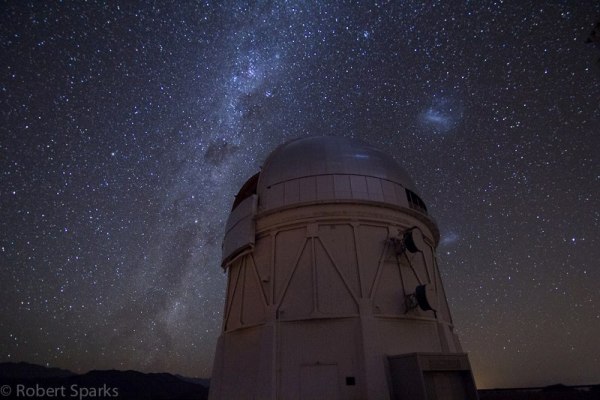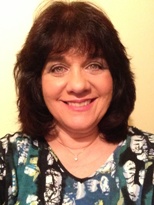by Connie Walker
- Published: Saturday, April 06 2013 17:00

From the dark night site of the 4m telescope at CTIO in Chile, jewels of the Night bedazzled Connie Walker (blog author) and Rob Sparks (photographer and NOAO EPO education specialist)
Over the past eight years GLOBE at Night (GaN) has become the most popular campaign in the world for fighting light pollution. What started as a grassroots light pollution study is now a worldwide campaign in its eighth year. It also was a centerpiece of the International Year of Astronomy Dark Skies Awareness cornerstone project.
I just spent two weeks in Chile at the headquarters of our sister observatory—NOAO-South—and was amazed at how much of its education and public outreach (EPO) effort revolved around the GaN program and at how well they were reaching audiences in a variety of ways.
We spent a couple of nights at Cerro Tololo Inter-American Observatory, met with the guides and directors of two astro-tourism observatories, visited classrooms in four schools, met with a couple of mayors, and toured the Humboldt Penguin Reserve national park. We started new projects with a biodiversity organization, a coastal environmental center, and university science education professors. We traveled 1,000 km for workshops about GaN presented by our colleague Juan Seguel. We discussed dark sky policies for urban development with Pedro Sanhueza, regional director of the office for the protection of the night sky, and with light pollution pundit Malcolm Smith.
GLOBE at Night seeks to raise awareness about light pollution and turn that awareness into action. The NOAO-North EPO group’s efforts include an array of activities along with GaN. We hold teacher workshops and hands-on, minds-on education sessions with children. We also work with college students and scientists using GaN data to study topics as varied as the behavior of bats and changes in darkness of the night sky over time in Tucson and its surrounding observatory mountaintops.
People all over the world are making a difference for dark skies. Here are just a few examples.
After spending time at Seven Hills Observatory in Kearny, Nebraska a group of Horizon Middle School students decided to help make the night sky more visible from their town. They convinced the Kearney City Council to declare March to be Dark Sky Month. They plan to raise awareness throughout the year, but especially next March, focusing on the importance of shielding lights.
Some teachers use extra credit to encourage students to participate in the program. Beverley Sutton has created seven webpages announcing ways her eighth grade science class in Tucson can be part of GaN campaigns! Science teacher Stephanie Hanover from Davila Middle School in Bryan, Texas encouraged the school’s Science Club to join the campaign. The astronomy club at the Senda Institute in Obregón, Mexico has launched a campaign to get their community involved in making measurements for GaN.
Recently a fourth-grader named Victoria contacted the International Dark-Sky Association (IDA) with some questions about light pollution. She was working on a science fair project and had heard that light pollution could be increasing cancer in humans. "This concerns me,” she wrote. “I would like to educate my friends about this." Victoria won first place in the science fair with her project, "The Dark Side of Light." She also wrote to her city's mayor, who responded that her concerns were being brought to the attention of the city's health department. She's well on her way to making a big difference in her community!
Vanessa Go is an elementary school science teacher in New York City and coordinator of a youth group called the Junior School Green Team. They organized a GaN viewing at their school because of their concerns with energy conservation as well as the ability to view a starry night sky.
Amateur astronomy clubs are spreading the word and participating, notably the Tucson Amateur Astronomy Association and the Willingboro Astronomical Society in New Jersey. Such citizen-science/research groups as the International Astronomical Search Collaboration and the SPACE Consortium from India have successfully reached hundreds of people who have contributed observations to the campaign.
North Carolina is celebrating GLOBE at Night and Global Astronomy Month by having 45 star parties across the state. This is part of the month-long NC Science Festival sponsored by UNC’s Planetarium and Science Center.
Almost all sixth grade teachers in Yuma, Arizona have enrolled in light pollution and GaN workshops operated by NOAO and funded by the Arizona Public Service Foundation. They are participating in the campaign and seriously diving into aspects of the effects of light pollution on their community. The teachers learn why shielding is important and which lights are considered better than others and why. They also received training and equipment to do an outdoor lighting audit and will present their findings to the public May 3.
NOAO, with funding from the International Astronomical Union’s Office of Astronomy for Development, will shortly be starting a project called “Dark Skies Outreach to Sub-Saharan Africa”. In Portugal Rita Guerra and Rosa Doran are taking light pollution awareness by storm. They have been effective through the Dark Skies Rangers program, part of GLOBE at Night and the Galileo Teacher Training Program, and a Facebook page chronicles their activities.
We would very much enjoy hearing more international stories like these. Please feel free to contact me at [email protected] Correspondence from people about how their GaN work is going keeps me going!
Each of us can help locally to make a global difference. Consider encouraging people to participate in GLOBE at Night or the Adopt a Street program. Become involved in the Dark Skies Awareness programs during this month’s Global Astronomy Month. In addition to GaN, these programs include International Dark Sky Week, hosted by IDA, and the Earth and Sky Photo Contest, mainly hosted by The World At Night. There are free downloadable resources too you may be interested in. For instance, the IDA education committee and Loch Ness Productions just produced "Losing the Dark", a free 6-minute full-dome planetarium show (with a flatscreen version).
We look forward to you joining us.
# # #
 Astronomer Connie Walker specializes in education and public outreach for the National Optical Astronomy Observatory (NOAO). She’s had a blast managing several programs for the public, students and teachers on hands-on general astronomy, dark skies preservation, optics and solar research. To help make a difference, she’s an officer on the Boards of Directors for the Astronomical Society of the Pacific and the International Dark-Sky Association (IDA), and the International Astronomical Union’s commission on light pollution. The highlight of her job is directing the popular international light pollution tracking campaign, GLOBE at Night. For her efforts in bringing dark skies awareness to the public, Dr. Walker won IDA’s Hoag-Robinson award in 2011.
Astronomer Connie Walker specializes in education and public outreach for the National Optical Astronomy Observatory (NOAO). She’s had a blast managing several programs for the public, students and teachers on hands-on general astronomy, dark skies preservation, optics and solar research. To help make a difference, she’s an officer on the Boards of Directors for the Astronomical Society of the Pacific and the International Dark-Sky Association (IDA), and the International Astronomical Union’s commission on light pollution. The highlight of her job is directing the popular international light pollution tracking campaign, GLOBE at Night. For her efforts in bringing dark skies awareness to the public, Dr. Walker won IDA’s Hoag-Robinson award in 2011.








Comments